SPES / SPES² patented technologiesy classify the single particles in a mix based on their optical properties. Location of data in the 3D histogram EOS CLOUDS is an multiparametric calibration-free optical fingerprint of the sample.
(in figure) Projection of the 3D EOS CLOUDS histogram for a sample of PS 0.5µm spheres dispersed in milliQ-grade water. Position of experimental data (grey tones proportional to relative numerical concentration). Red line represents expected SPES / SPES² position for PS spheres with different sizes.
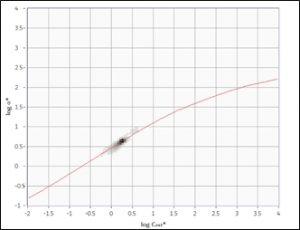
Experimental SPES / SPES² data are calibration-free and compared to theoretical expected positions in the multiparametric histogram for dielectric spheres of different sizes and refractive indexes. Different approaches can be tempted, as tailored Mie or DDA. The most compatible effective refractive index is thus automatically determined by Classizer™ ONE, in this case as n=1.60, in agreement within experimental error with theoretical value at λ=640nm. Once retrieved the effective refractive index, particles are individually sized comparing their S(0) values with expected ones for spheres of different diameters. Classizer™ ONE provides to user the Numerical Particle Size Distribution and other statistical values as AVG, CV, and quantiles.
In case of heterogeneous samples in terms of the sizes and/or of the refractive indexes, secondary populations could limit, or even preclude any reliable approaches with traditional analytical methods. Thanks to the SPES / SPES² patented multiparametric approaches, Classizer™ ONE discriminates particles basing on optical properties. Heterogeneous samples produce simultaneously more clouds for each particle population which can be easily individually selected, analysed, and compared. Specific data analysis and data reduction methods provided by EOS result in a complete selection and characterization of the heterogeneous particles.
In the next figures we present examples of heterogeneous samples with more than one component. Separate clouds corresponding to optical different particles are detected and represented on the EOS CLOUDS. In the first one, SPES experimental data of a mix of PS and PMMA particles with same size are presented. In the second one, the detection of PS submicron particles mixed with an emulsion of silicon oil is evaluated. In the third one SPES measures and counts how many particles of given optical properties are present in a complex fluids as biological matrix of cell lysate.
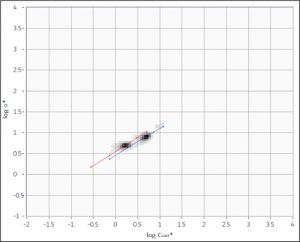
(in figure) Example of EOS CLOUDS for a mix of PMMA 600nm and PS 600nm submicron particles. Two clouds are detected and can be selected and analyzed separately, as well as for the absolute/relative concentration of each population. Red and blue lines are expected trends for PMMA and PS, respectively.
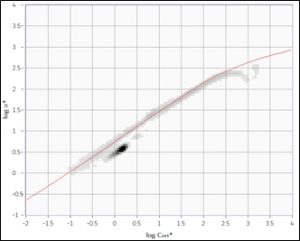
(in figure) Example of EOS CLOUDS for a heterogeneous sample of silicon oil emulsion with polystyrene 0.5µm spheres as traceable particles. Two principal and separated populations are detected. Red line represents expected size trend for droplets of castor oil refractive index.
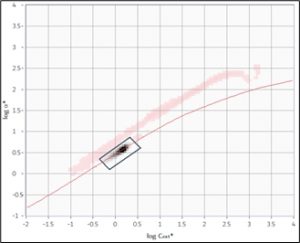
(in figure) Example of a selection of an area on the EOS CLOUDS to focus and refine particle analysis on a fraction of the whole particulate system detected (blue closed line). This capability can be used to analyse single components, tails in polydisperse distributions, and impurities.
(in figure) SPES / SPES² discriminate, measure, and count how many particles of given optical properties are present in a lysate of cells with uptake of submicron polymeric particles. SPES / SPES² retrieve the particle numerical concentration in the supernatant of three cell coltures and the numerical concentration and particle stability directly in diluted cell lysates without any purification or filtration.
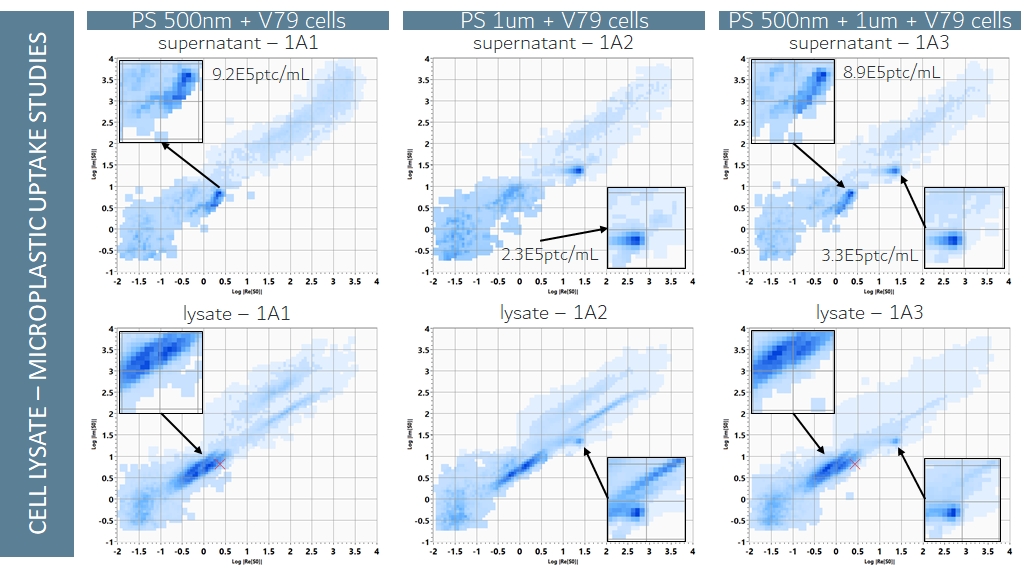
Optical classification opens up new opportunities in particles analysis: work directly in complex heterogeneous fluids, avoid preliminary purification process, do not care about impurities or secondary populations, and more. This capability is of capital importance for a proper characterization of particle in complex fluids, characterization of drug delivery systems, and characterisation of particles in environmental fluids, regardless the presence of impurities – e.g. no preliminary purification or filtration are required.
